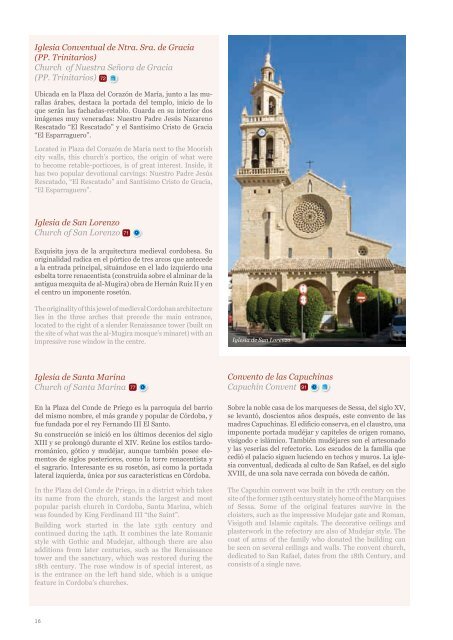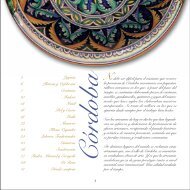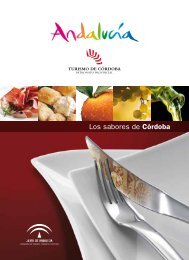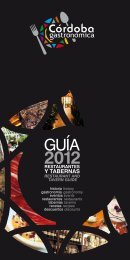You also want an ePaper? Increase the reach of your titles
YUMPU automatically turns print PDFs into web optimized ePapers that Google loves.
Iglesia Conventual de Ntra. Sra. de Gracia<br />
(PP. Trinitarios)<br />
Church of Nuestra Señora de Gracia<br />
(PP. Trinitarios) 72<br />
Ubicada en la Plaza del Corazón de María, junto a las murallas<br />
árabes, destaca la portada del templo, inicio de lo<br />
que serán las fachadas-retablo. Guarda en su interior dos<br />
imágenes muy veneradas: Nuestro Padre Jesús Nazareno<br />
Rescatado “El Rescatado” y el Santísimo Cristo de Gracia<br />
“El Esparraguero”.<br />
Located in Plaza del Corazón de María next to the Moorish<br />
city walls, this church’s portico, the origin of what were<br />
to become retable-porticoes, is of great interest. Inside, it<br />
has two popular devotional carvings: Nuestro Padre Jesús<br />
Rescatado, “El Rescatado” and Santísimo Cristo de Gracia,<br />
“El Esparraguero”.<br />
Iglesia de San Lorenzo<br />
Church of San Lorenzo<br />
Exquisita joya de la arquitectura medieval cordobesa. Su<br />
originalidad radica en el pórtico de tres arcos que antecede<br />
a la entrada principal, situándose en el lado izquierdo una<br />
esbelta torre renacentista (construida sobre el alminar de la<br />
antigua mezquita de al-Mugira) obra de Hernán Ruiz II y en<br />
el centro un imponente rosetón.<br />
71<br />
The originality of this jewel of medieval Cordoban architecture<br />
lies in the three arches that precede the main entrance,<br />
located to the right of a slender Renaissance tower (built on<br />
the site of what was the al-Mugira mosque’s minaret) with an<br />
impressive rose window in the centre.<br />
Iglesia de San Lorenzo<br />
Iglesia de Santa Marina<br />
Church of Santa Marina<br />
Convento de las Capuchinas<br />
Capuchin Convent<br />
77 91<br />
En la Plaza del Conde de Priego es la parroquia del barrio<br />
del mismo nombre, el más grande y popular de Córdoba, y<br />
fue fundada por el rey Fernando III El Santo.<br />
Su construcción se inició en los últimos decenios del siglo<br />
XIII y se prolongó durante el XIV. Reúne los estilos tardorrománico,<br />
gótico y mudéjar, aunque también posee elementos<br />
de siglos posteriores, como la torre renacentista y<br />
el sagrario. Interesante es su rosetón, así como la portada<br />
lateral izquierda, única por sus características en Córdoba.<br />
In the Plaza del Conde de Priego, in a district which takes<br />
its name from the church, stands the largest and most<br />
popular parish church in Cordoba, Santa Marina, which<br />
was founded by King Ferdinand III “the Saint”.<br />
Building work started in the late 13th century and<br />
continued during the 14th. It combines the late Romanic<br />
style with Gothic and Mudejar, although there are also<br />
additions from later centuries, such as the Renaissance<br />
tower and the sanctuary, which was restored during the<br />
18th century. The rose window is of special interest, as<br />
is the entrance on the left hand side, which is a unique<br />
feature in Cordoba’s churches.<br />
Sobre la noble casa de los marqueses de Sessa, del siglo XV,<br />
se levantó, doscientos años después, este convento de las<br />
madres Capuchinas. El edificio conserva, en el claustro, una<br />
imponente portada mudéjar y capiteles de origen romano,<br />
visigodo e islámico. También mudéjares son el artesonado<br />
y las yeserías del refectorio. Los escudos de la familia que<br />
cedió el palacio siguen luciendo en techos y muros. La iglesia<br />
conventual, dedicada al culto de San Rafael, es del siglo<br />
XVIII, de una sola nave cerrada con bóveda de cañón.<br />
The Capuchin convent was built in the 17th century on the<br />
site of the former 15th century stately home of the Marquises<br />
of Sessa. Some of the original features survive in the<br />
cloisters, such as the impressive Mudejar gate and Roman,<br />
Visigoth and Islamic capitals. The decorative ceilings and<br />
plasterwork in the refectory are also of Mudejar style. The<br />
coat of arms of the family who donated the building can<br />
be seen on several ceilings and walls. The convent church,<br />
dedicated to San Rafael, dates from the 18th Century, and<br />
consists of a single nave.<br />
16







